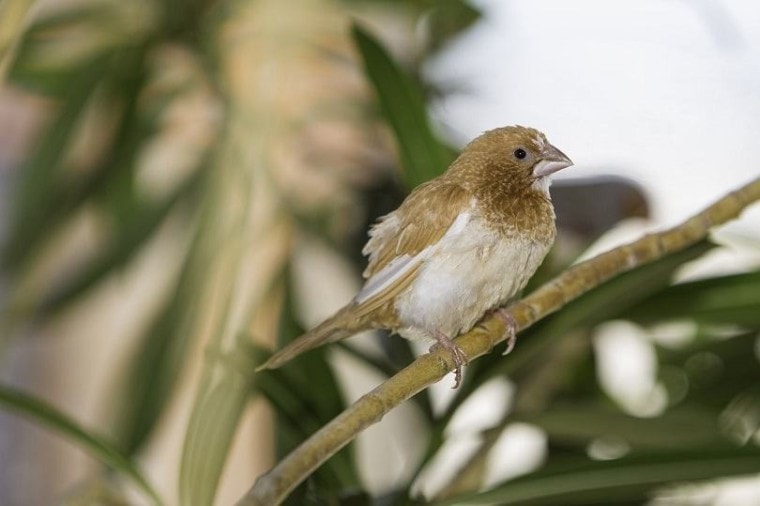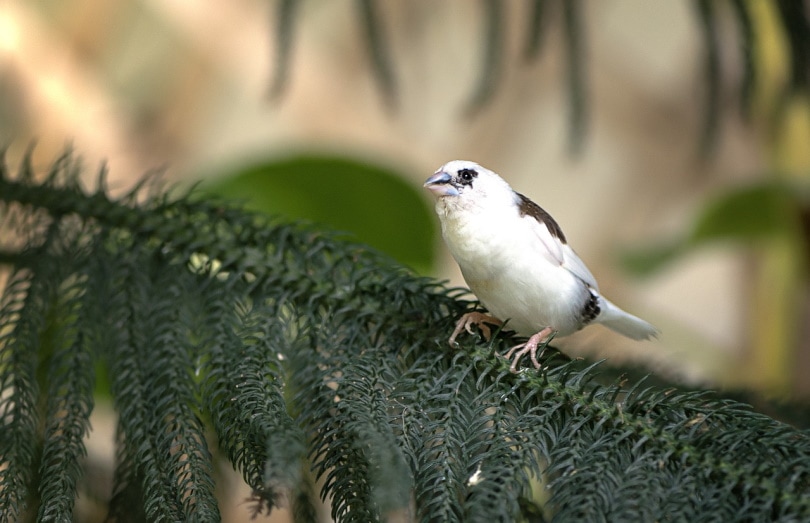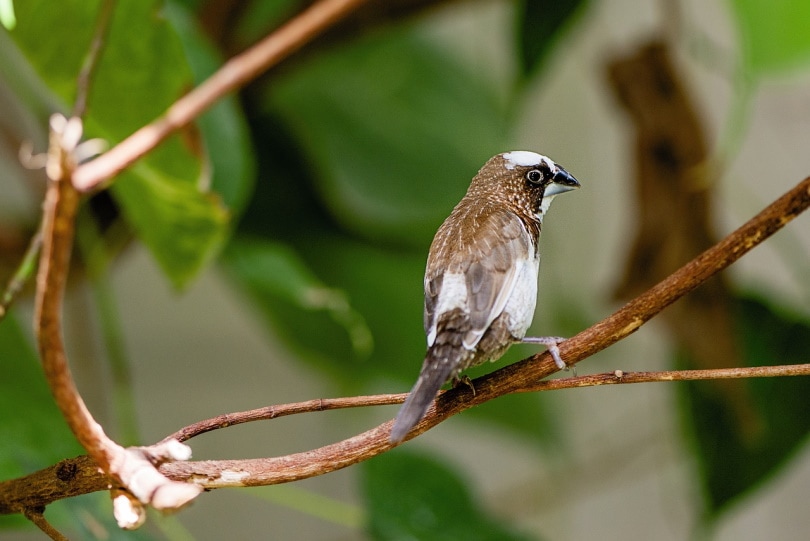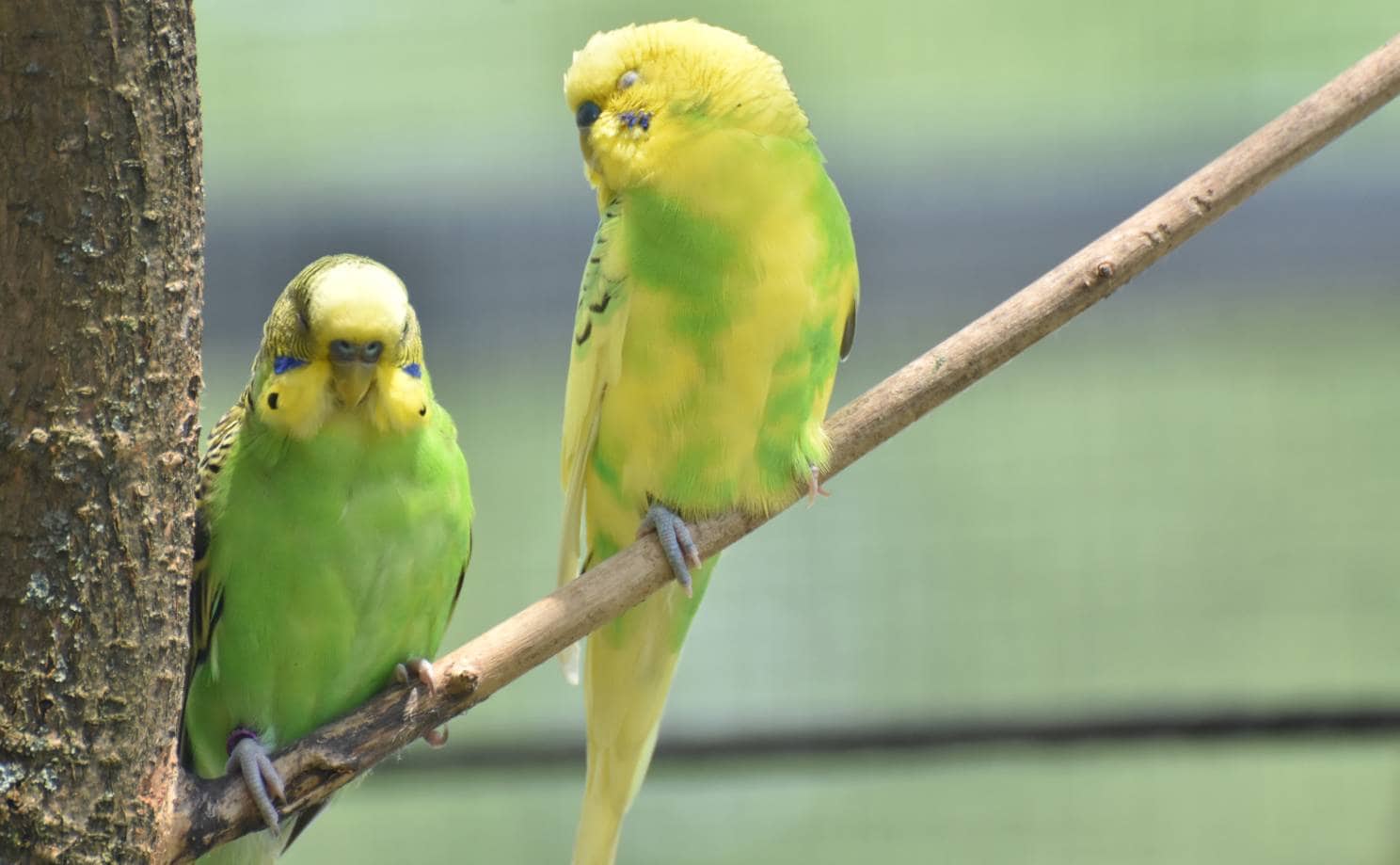
The Society Finch, also known as the Bengalese Finch, is a popular domesticated Finch species. They are not found in the wild; therefore, they are common cage birds. Unlike parrots, these birds don’t talk, but they can sing, entertaining the owners.
These birds are small-sized and come in a wide variety of colors. Using selective breeding, breeders have developed several color variations, including pied, fawn, and chocolate brown. These finches also live up to their name and tend to socialize with people or birds near their habitat.
Society Finches are readily available in pet stores and are not very expensive. Because of these factors, they are a great addition to your aviary.

Species Overview
| Common Name: | Society Finch or Bengalese Finch |
| Scientific Name: | Lonchura domestica |
| Adult Size: | 4 – 5 inches |
| Lifespan: | 3 – 7 years |

Origin and History
The history of this bird species is pretty unclear because, unlike other pet birds, they are not present in the wild. As the only Finch that doesn’t live in the wild, they are believed to have been developed in Asia by Japanese and Chinese breeders. According to its ancestry, this bird is assumed to be a crossbreed of the White-backed Munia and sharp-tailed finch species.
While the Society Finch is a very popular cage and lab bird, the parent species are not present in zoos or private collections. This bird is an ideal pet for breeders who want an easy-to-breed bird with an exciting history.

Temperament
Just like their name, these birds are very social. They have highly developed parental instincts and will breed easily.
Because of their social personalities, breeders and zoos use them as foster parents for the chicks of other species. They help in fostering abandoned chicks, which is also an essential breeding technique.
Society Finches thrive well in the company of other birds and will adapt well to living in groups. They are non-aggressive, friendly, and have an ideal temperament to co-exist with other bird species. In case of an attack, they’ll be the first to back down if confronted by a more aggressive finch.
They are challenging to handle because of their small size. Because these Finches are very peaceful, they only get startled and start to fly in the enclosure when they aren’t nesting or eating. If they try to bite you, they only deliver a little pinch because they have a small beak.
Among other Finch bird species, they are the most peaceful Finches.

Speech and Vocalizations
Unlike other bird species such as parrots, Society Finches don’t talk or scream. However, they make some sounds that come off as chatter, beeps, and warbles.
However, they are well known for their singing. The songs vary among individual males and will differ according to the male who raised the specific bird.
Because of this, Society Finches have been used in laboratories to study vocalizations. Their songs have a unique syntax and structure.
Over the years, the song production among the Bengalese Finch has evolved. Researchers have continued to study the different ways these songs and produced and processed in the brain. The studies also include the differences in song production between the male and female Finches.
The male songbirds create their own songs through learning and have their distinct variations. Females are less likely to sing compared to their counterparts.

Society Finch Colors and Markings
Male and Female Society finches come in different color combinations. These can be either brown, white, or tan shades.
The most common color mutations are pied; white color patches, fawn, chestnut, chocolate brown, red-brown, white-crested, albino, pearl, and grey. Some of these color variations are sex-linked recessive.
Society Finches are sexually monomorphic species, making it hard to distinguish between male and female birds. The beak is usually two-toned with dark grey colors on the top and silver below.
The feathers around the beak and throat are a blend of black and chocolate brown. The rest of the body, especially the chest and belly area, is primarily off-white with chocolate feathers.

Caring for the Society Finch
Once you get a Society Finch, here are some of the things you need to consider to ensure your bird lives comfortably.
Shelter
Society Finches are active birds; therefore, they require a large cage to fly around comfortably. They thrive in a space which they can socialize, sing and play without feeling crowded. They also jump and fly mostly from side to side; hence it’s better to have a wide cage over a tall one.
If you install a flight cage, the bar spaces should be small to prevent your bird from escaping, especially since they are very tiny. The aviary should also have a nest where your pet bird can sleep and cuddle. Society finches don’t thrive well in cold temperatures; therefore, you should have the ideal temperatures at about 75 degrees.
These bird species need socialization; therefore, they need to be kept together with other Finches. However, if your Society Finches are for breeding or fostering purposes, you’ll have to house them in individual breeding cages after sexing. When choosing compatible partners, ensure you don’t pair them up with aggressive birds.
Unlike most pet birds, these bird species don’t play much with toys. However, they enjoy swings and ladders.
In the cage, you can install some perches and swings to keep the bird engaged. Ensure you don’t overcrowd the cage too much because this hinders the bird from moving around freely and stretching.
The birdcage should also be placed away from high-traffic areas or areas with temperature fluctuations. Avoid having the cage near the door or next to a heating or cooling system. In addition, the aviary should be in a location free from aerosols and fumes.

Grooming
Society Finches enjoy a good bath; therefore, you should provide a shallow plastic bath for the bird. The owners should also clean the bath regularly and change the water.
Apart from a bath, it would be best if you also trim your bird’s nails regularly. Bird nail trimmers are readily available at pet shops. Also, ensure that you don’t clip into the vein when cutting the nails; this could lead to excessive bleeding, which can be fatal.

Common Health Problems
Society Finches are hardy birds. Most of their illnesses are a result of dirt cages or an improper diet.
If you provide your pet bird with a proper diet and plenty of exercise, you can easily prevent most illnesses. For instance, albino Finches are prone to eye problems. You can avoid this problem by feeding your bird lots of green foods that are high in carotene.
Like other Finches, Society Finches are also prone to two types of parasites. They get attacked by air sac mites or Sternostoma tracheacolum, which reside in the respiratory tract. These parasites can be very dangerous and even life-threatening if they are not treated on time.
The other type of parasite, the scaly face mites or Knemidokoptes pilae, causes scales to appear on the skin. You need to regularly check and observe your Society Finch, spot these scales, and get medical help. Once you identify any symptoms, you should see your veterinarian immediately to keep your pet bird alive and healthy.
Apart from mites, these Finches are also prone to overgrown beaks and nails. These are manageable as long as you keep them trimmed.
Knowing your bird’s behavior is crucial in identifying illness. Some of the signs to look out for include ruffled feathers, lack of appetite, droppings that are not black and white, wheezing, and a weak bird.
Diet and Nutrition
Finches require a good seed mix that includes canary seed, cereal seeds, and millet. When choosing a diet, it should be a high-quality pelleted diet designed for finches.
You can easily get pelleted foods at your pet store which contain the appropriate nutrients and vitamins. In addition, Finches also enjoy greens in their diet, such as dandelion greens, kale, parsley, and spinach.
A seed diet is not balanced; therefore, you should include fresh fruits, vegetables, cooked eggs, and other food items. Your Society Finch will enjoy apples, bananas, and apricots. The earlier you introduce new foods, the more likely they are to eat them.
On top of the food, ensure you provide your bird with some water every day. Have the food and water served on clean bowls to prevent contamination that can affect your bird’s health.
Exercise
Society Finches are active breeds. When providing a cage, you need to consider these needs and provide enough space for the bird to hop around and fly. By adding some perches, ladders, and swings, your bird can fly around and play without any issues.
The flight cage or aviary should also be large enough to handle the bird and protect it from injuring its wings. Broken wings or feet can be a problem for your bird, especially if they have other medical conditions.
Providing enough exercise for your bird is vital in ensuring that they stay healthy and protected from illnesses. Therefore, you need to ensure that the cage is well-suited for your pet bird. If you have more than one bird, ensure the space is large enough to meet the exercise needs of each.

Where to Adopt or Buy a Society Finch

If you are looking for a Society Finch, you’ll have it easy. They are readily available in pet stores that sell birds.
You can also get them at bird rescues or the breeders. They are mostly available in the three basic colorations. However, you can still get the tri-colors, crested or solid colors at the breeders.
Because they are easily bred, these tiny birds are inexpensive and could cost you less than $30. Therefore, before settling on a source, you can compare them to ensure you get a healthy bird.
If you go the breeders’ way, ensure you get all the information about the Society Finch. To confirm that the bird is well-taken care of, you can go a step further and take a tour of the facility to verify that the birds are cared for in clean cages and well-fed. In addition, a good breeder should be able to provide documentation and background history to know whether your bird has any potential medical conditions.
When you are ready to adopt or buy the Society Finch, you should also budget for the initial supplies you need, such as a cage, perches, food and water bowls, and other key needs.

Summary
The Society Finch is a tiny, active, and social bird. Known for its social personality, it co-exists well with other birds and acts as an excellent foster parent for abandoned chicks. This bird is low-maintenance and easy to breed; therefore, it can be easily found in pet stores.
Like any other bird, you need to provide your pet with the proper nutrition and ensure it gets enough exercise to stay healthy. This bird species is easy to manage as long as you provide the necessary housing, diet, grooming, and plan for regular vet visits.
Society Finches are good singers. If you are looking for a companion, this pet bird will keep you entertained.
You May Also Like:
Featured Image Credit: timokefoto, Pixabay








